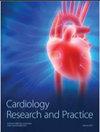Global Longitudinal Strain May Be the One that Appropriately Identifies Candidates of ICD Implantation
IF 1.8
4区 医学
Q3 CARDIAC & CARDIOVASCULAR SYSTEMS
引用次数: 0
Abstract
Hypertrophic cardiomyopathy (HCM) significantly contributes to an elevated risk of sudden cardiac death. Primary prevention is implemented by using an implantable cardioverter defibrillator (ICD). However, all of the HCM patients do not really need ICD therapy. Providing a superior index for ICD indication compared with the current indices like ejection fraction is essential to differentiate high-risk patients efficiently. The present study assessed the potential of global longitudinal strain (GLS) for the differentiation of HCM patients based on their need for ICD shocks. Patients with HCM were considered in four defined centers between March and June 2021. Those with previous ICD implantation or current candidates for ICD therapy were included in the study. Participants were subjected to speckle-tracking echocardiography, and GLS as well as some other echocardiographic parameters were recorded. Afterwards, data from implanted ICDs were extracted. Patients who received ICD shocks (appropriate) due to ventricular tachycardia (VT)/ventricular fibrillation (VF) were categorized in group A. The remaining patients were constituted group B who received inappropriate shocks, i.e., other than VT/VF. Overall, 34 patients were found eligible to participate with a mean age of 62 ± 16.1 years including 64.7% of males. Among a variety of echocardiographic parameters, GLS was the sole one that was significantly higher in group A compared with that in group B. Our findings revealed that only GLS could predict fatal arrhythmias. To substantiate, the odds of VT were raised by 43% with a single increase in GLS unit. GLS showed the highest accuracy for ICD indication among HCM patients and, therefore, could be a solid and early criterion to predict the incidence of life-threatening arrhythmias. In this regard, identifying appropriate HCM patients with respect to their need for ICD therapy is feasible.全局纵向应变可能是恰当识别 ICD 植入候选者的因素之一
肥厚型心肌病(HCM)是导致心脏性猝死风险升高的重要原因。通过使用植入式心律转复除颤器(ICD)可实现一级预防。然而,并非所有 HCM 患者都真正需要 ICD 治疗。与目前的射血分数等指标相比,为 ICD 适应症提供更优越的指标对于有效区分高危患者至关重要。本研究评估了全纵向应变(GLS)在根据 ICD 冲击需求区分 HCM 患者方面的潜力。2021 年 3 月至 6 月间,四个确定的中心对 HCM 患者进行了考虑。曾植入过 ICD 或目前正在接受 ICD 治疗的患者均被纳入研究范围。参与者接受斑点追踪超声心动图检查,并记录 GLS 及其他一些超声心动图参数。随后,提取植入 ICD 的数据。因室性心动过速(VT)/室颤(VF)而接受 ICD 电击(适当)的患者被归入 A 组。共有 34 名患者符合参与条件,平均年龄(62 ± 16.1)岁,其中男性占 64.7%。我们的研究结果表明,只有 GLS 可以预测致命性心律失常。为了证实这一点,GLS 单位每增加一个,VT 的几率就会增加 43%。在 HCM 患者中,GLS 对 ICD 适应症的准确性最高,因此,它可以作为预测危及生命的心律失常发生率的可靠早期标准。因此,根据 HCM 患者对 ICD 治疗的需求来确定合适的 HCM 患者是可行的。
本文章由计算机程序翻译,如有差异,请以英文原文为准。
求助全文
约1分钟内获得全文
求助全文
来源期刊

Cardiology Research and Practice
Medicine-Cardiology and Cardiovascular Medicine
CiteScore
4.40
自引率
0.00%
发文量
64
审稿时长
13 weeks
期刊介绍:
Cardiology Research and Practice is a peer-reviewed, Open Access journal that publishes original research articles, review articles, and clinical studies that focus on the diagnosis and treatment of cardiovascular disease. The journal welcomes submissions related to systemic hypertension, arrhythmia, congestive heart failure, valvular heart disease, vascular disease, congenital heart disease, and cardiomyopathy.
 求助内容:
求助内容: 应助结果提醒方式:
应助结果提醒方式:


